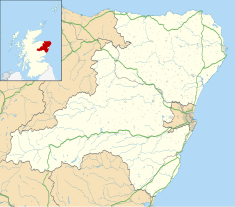Wormy Hillock Henge, also known as The Dragon's Grave, is a small henge in Aberdeenshire, Scotland.[3] It is a Scheduled Ancient Monument[1] located in the Clashindarroch Forest.[4] It is a low, circular bank 16.5 metres (54 ft) in diameter which almost surrounds a 6-metre (20 ft) wide platform in the centre.[3] There is one gap in the bank at the southeast end of the henge.[3]
| Wormy Hillock Henge | |
|---|---|
 A picture of the mound; the henge lies in the left half of the photo | |
| Location | Aberdeenshire, Scotland |
| Coordinates | 57°21′48.32″N 2°55′3.40″W / 57.3634222°N 2.9176111°W |
| Built | During the Neolithic Period[1] |
| Architectural style(s) | British pre-Roman Architecture |
| Official name | Wormy Hillock |
| Reference no. | 3278[2] |
Wormy hillock henge shown within Aberdeenshire | |
History
editIn 1891, James Macdonald, thinking that this mound was a "round for sheep", excavated the mound. However, this did not bring any archaeological finds.[4]
Legend
editAccording to legend, Wormy hillock henge was the location of a buried dragon or monster.[4][5] In the legend, the dragon had been attacking villages in the neighbourhood, and the villagers eventually succeeded in killing the dragon. They then half-buried its corpse and mounded dirt over it, making a mound.[6] This legend is the source of the names of the mound: Wormy Hillock Henge and The Dragon's Grave.[5][6]
The site
editThe henge is located to the south of the mound known as Wormy Hillock, on a haugh ("a piece of flat alluvial land by the side of a river", according to the Oxford English Dictionary[7]) in a steep valley[4] in the Clashindarroch Forest. The henge comprises a circular bank, 16.5 metres (54 ft) in diameter,[8] enclosing an oval area 13.5 metres (44 ft) long by 13 metres (43 ft) wide.[4] The bank itself ranges from 3 metres (9.8 ft) broad and 10 centimetres (3.9 in) high up to 4 metres (13 ft) thick and 60 centimetres (24 in) high.[4] Wormy Hillock falls into the sub-category 'mini-henge' or 'hengiform' as it is less than 20m in diameter (see henge main article). The area enclosed by the bank is around 140 square metres (1,500 sq ft), and the average for a stone circle is around 260 square metres (2,800 sq ft).[9]
Inside the bank is a small platform 6 metres (20 ft) in diameter surrounded by a 1 metre (3.3 ft) deep ditch crossed by several causeways.[4] The southeastern one is apparently related to the 1 metre (3.3 ft) wide hole in the bank at the same angular position.[3][4] This site is similar to several others in Dorchester, Oxon, England.[8] There are two small pits on the bank, and they may be much more recent than the rest of the mound. A large boulder is lying in the ditch right below one of the pits.[4]
Currently, the site is completely overgrown by grass and heather.[4]
Gallery
edit-
A front view of the burial mound, showing the small valley plain.
-
A panoramic photograph showing the circular bank in front of the burial mound.
-
A side view panoramic photograph of the Wormy Hillock burial mound, showing the small river which runs next to it.
See also
editReferences
edit- ^ a b Dip, Jill Moody (2006). Electricity Act 1989 (PDF) (Report). The Scottish Executive Inquiry Reporters Unit. Retrieved 7 December 2010.
- ^ The Diversity Team (September 2009). Moray & Aberdeenshire Forest District Strategic Plan 2009–2013 (PDF) (Report). Forestry Commission Scotland. Retrieved 7 December 2010.
- ^ a b c d "Wormy Hillock Henge". Megalithic Portal. Retrieved 7 December 2010.
- ^ a b c d e f g h i j "Wormy Hillock". Canmore Site Records. Royal Commission on the Ancient and Historical Monuments of Scotland. Retrieved 7 December 2010.
- ^ a b MacDonald, James (1891). Place Names in Strathbogie. Dwyllie and Son. pp. 258–259.
- ^ a b "Wormy Hillock Henge Monument". Attractions in Aberdeenshire. Britain Express. Retrieved 7 December 2010.
- ^ "haugh, n." Oxford English Dictionary. 2nd ed. 1989. OED Online. Oxford University Press. 16 December 20.
- ^ a b "Aberdeenshire SMR – Wormy Hillock". Aberdeenshire Council Sites and Monument Record. Aberdeenshire Council. Retrieved 7 December 2010.
- ^ Burl, Aubrey (August 2000) [First published 1995]. The Stone Circles of Britain, Ireland, and Brittany (2nd ed.). Yale University Press. pp. 36. ISBN 978-0-300-08347-7.
wormy hillock.
